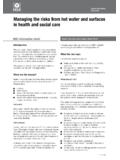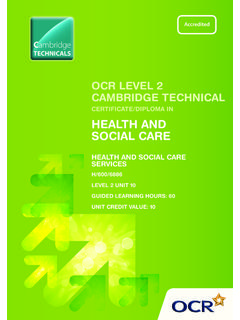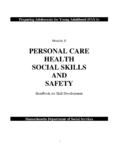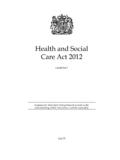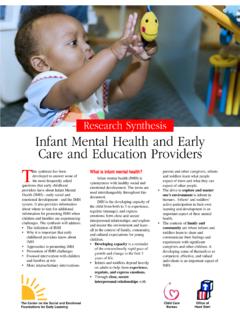Transcription of Falls from windows and balconies in health and …
1 1 of 3 pagesHealth and Safety ExecutiveHealth and Safety ExecutiveHealth Services Information Sheet No 5 HSE information sheetFalls from windows or balconies in health and social careIntroductionThis information sheet provides advice on controlling risks to people who use health and social care services (service users) associated with Falls from windows or balconies . It aims to help providers of health and social care services comply with their legal duties. Accident data continue to highlight the serious issue of service users falling from windows or balconies in health and social care premises.
2 These often result in fatal or serious injury and there have been several successful prosecutions by HSE following accidents to vulnerable nature of the problemThere are three broad categories of Falls : accidental Falls ; Falls arising out of a confused mental state; deliberate self-harm. Accidental Falls can occur where a person is sitting on a window sill, or where the sill or banister height is low and acts as a pivot, allowing them to fall. These are rare but can affect employees as well as service users. Many reported accidents involve people in either a temporary or permanent confused mental state, often caused by: senility or dementia; reduced mental capacity; mental disorder; alcohol or drugs (both prescribed and illegal).
3 In some cases, individuals try to escape from an environment they perceive to be hostile, or use a window, believing it to be an exit, unaware that they are not at ground level. Other factors may include unfamiliarity with new surroundings (eg short stays at respite care centres), uncomfortable temperatures, broken sleep and medication effects. Deliberate self-harm is a recognised risk for people with certain mental health conditions. Although not reportable under the Reporting of Injuries, Diseases and Dangerous Occurrences Regulations 2013 (RIDDOR), suicides can still be a matter for investigation.
4 What the law saysThe following legislation applies to employers duties to service users: health and Safety at Work etc Act 1974, section 3 Management of health and Safety at Work Regulations 1999, regulation 3 Complying with the following legislation, dealing with employers duties to employees, will also help reduce the risk to service users: Workplace ( health , Safety and Welfare) Regulations 1992 Regulation 14 applies to glazing material and where necessary requires windows to be constructed of safety material (eg safety glass) or otherwise protected against breakage (eg by means of a screen or barrier).
5 The Approved Code of Practice (ACOP)1 states that if a person going through the glass would fall from a height, and a screen or barrier is used, then it should be designed to be difficult to climb. Regulation 15 applies to risks associated with windows , skylights and ventilators. Where there is a risk of falling from height, the ACOP requires provision of devices that prevent the window opening too far (eg window restrictors). The bottom edge of openable windows should be at least 800 mm above floor level, unless there is a barrier to prevent legal requirementsFire safety Residential care premises, or rooms or homes owned within the care facility, should have an evacuation plan and suitable means of escape.
6 Fire safety guidance2 2 of 3 pagesHealth and Safety Executivefor residential care premises states that using windows as a means of escape is not normally acceptable and should only be considered in exceptional Regulations Building Regulations do not require windows to be fully openable in every room within care or nursing home settings. They refer to the need for suitable limiters or guarding for windows above ground floor where there is a risk of you need to doRisk assessment To adequately manage the risk of Falls from windows or balconies , the care provider needs to assess the premises and service users.
7 Where assessment identifies that individuals are at risk from Falls then adequate arrangements should be in should include assessing the risk that furniture, or other items, may enable them to climb over barriers, or access windows which might otherwise be measuresSuitable controls may include: fitting adequate window restrictors; ensuring balconies have edge protection that is sufficiently robust, and of suitable design (including height, and the size of any openings in it), to prevent accidental Falls ; fitting an adequate screen or barrier to prevent service user access to a window or balcony edge; restricting access to upper floors.
8 Window restrictorsWhere vulnerable people have access to windows large enough to allow them to fall out and be harmed, those windows should be restrained sufficiently to prevent such Falls . Window restrictors should: restrict the window opening to 100 mm or less; be suitably robust to withstand foreseeable forces applied by an individual determined to open the window further; be sufficiently robust to withstand damage (either deliberate or from general wear); be robustly secured using tamper-proof fittings so they cannot be removed or disengaged using readily accessible implements (such as cutlery) and require a special tool or key (see Department of health Building Note 00-10 Part D windows and associated hardware3).
9 Please note that safety restricted hinges that limit the initial opening of a window can be overridden without the use of any tools and are not suitable in health and social care premises where individuals are identified as being vulnerable to the risk of Falls from windows . care providers should also: ensure the window frames to which restrictors are fitted are sufficiently robust; consider any impact on the comfort of service users from reduced natural ventilation and provide adequate cooling where necessary (eg high-level and/or restricted aperture ventilation, fans or air conditioning).
10 The NHS has produced guidance4 on dealing with extreme heat and heatwaves. BalconiesWhere assessment identifies that service users are at risk of falling, then sufficient protection should be provided to prevent them from accessing balconies or climbing over the balcony edge protection. This should take into account furniture or features with footholds which may allow access over the barrier (eg chairs, tables, plant pots, walls etc).Restricting access to upper floorsWhere service users are at risk of falling, the care provider must decide whether to apply protective measures throughout the premises, or to ensure that they only have access to safe areas, for example the ground must ensure that all safety fixtures and fittings are functioning effectively and their performance has not deteriorated as a result of use, wear or tampering.











